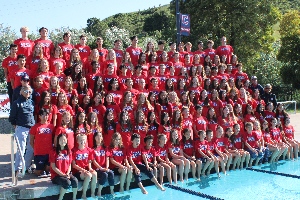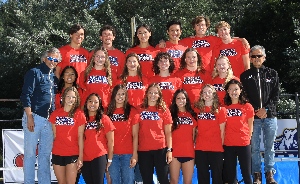Academic Considerations
Please find information below on the following:
- Finding your Academic Fit
- Informal College Visits
- Standardized Tests
- Letters of Recommendation
- College Interviews: Guidelines and Tips
- Questions to Consider
- Timeline
- Early Action/Early Decision
General Overview:
In developing a list of academic “fit” schools, some criteria to think about are:
First and foremost, find a college/university that offers the course of study you are interested in and find a school that you would want to be attending if, for some unforeseen reason, you were no longer able to swim. Certainly many high school students do not know what they want to major in but to the extent that you do know what you want or do not want, it makes it easier to narrow the search ie an architectural or engineering school or a liberal arts school. By the end of your Junior Year, the picture of who you are as a college applicant is virtually complete with your times, your GPA, standardized test scores, AP scores, activities, employment, etc. Now is the time to find a program that fits YOU. You now have most of the information that coaches and colleges will be basing their preliminary decisions on. Discuss potential colleges with your college counselor and research the academic reputation, programs and requirements of the various schools. This is easy to do with books (such as “The Princeton Review: The Best Colleges” or “Fiske’s Guide to Colleges” and there are many others available) or websites such as College Board or NCAA.org. For the students’ perspective (“tell it like it is”), refer to social media sights like College Confidential (www. collegeconfidential.com) or College Prowler (collegeprowler.com). It is important that you fairly assess both your academic and athletic abilities up front and to also establish your specific college criteria ie what are your top priorities in looking for a college? With this, it is much easier to narrow the field and then focus on the schools that will be the right overall fit for you. Compromises and adjustments may need to be made but you will have a starting point and a roadmap through the process.
The recent trend has been that colleges have become more and more competitive resulting in applicants applying to more and more colleges. Just a few years ago, applicants applied to 5-7 schools, but the norm has increased to 10-12. However, keep in mind that filling out college applications and answering personal statements and essay questions is time consuming. Applying to 20 universities would be a very difficult thing to do well. Even if applying Early Decision, you will still need to apply to other schools as most admissions decisions occur after application deadlines for other schools. Due to the unpredictability of the acceptance process, more and more kids are applying to more and more schools. This results in very few students getting into what used to be called “reach” schools. Depending on your swimming abilities, it may help you a little but in order to improve your chances and hedge your bet for a good fit, you may want to consider giving more focus to “match” schools. Just as you ascertain where you want to fit in on a team athletically, also ascertain where you want to fit in academically at a college. For example, do you want to go to an “academic reach” school and struggle with your course load while balancing your swimming commitment?
In other words, look at academic fit first and only then overlay the opportunity to participate on their swim team and see what that might look and feel like. Ask yourself whether or not you could see attending that school and living in that specific environment for four years.
Criteria you might want to consider:
- level of academics (after all, you are going to SCHOOL): median GPA and test scores. where do you want to fit in academically? top 25%, bottom 25% and what does that mean to you especially as both an athlete and as an non-athlete?
- academic reputation
- ability to get desired classes and the ability to graduate in four years
- Div 1, 2 or 3 (spectators perspective)
- size of the school: small, medium or large (smaller, same or larger than your high school?)
- size of the classes
- are classes taught by professors or by graduate students/teachers assistants?
- location: rural/suburban/urban
- proximity to airports or modes of transportation and time/cost required to travel home
- the feel and look of the school – how do you like it and the student body?
- community support ie proximity to stores, restaurants and support services
- weather
- majors offered
- acceptance rates
- liberal arts school vs research institution vs Ivy etc.
- housing availability and extent housing is guaranteed. what are the dorms like?
- social life and reputation
- presence or not of a Greek system (if interested and if allowed by the coach)
- ability to study abroad
- ability to do internships while in school
- strength of the alumni network for job contacts post graduation
- affordability and philosophy re: scholarship/financial aid (grants vs loans)
- school and team culture
- types of students that you see on campus. are they happy? would you fit in?
- balance of social and academic
- school philosophy
- what else is there to do nearby campus?
- what kind of academic support is available. what is the cost?
- what do the students do for fun?
- what are the school traditions and is there school spirit?
- is there an academic advisory system or academic counseling available?
- could you live there for four years?
Visit college campuses in your own backyard/informal college visits:
When you are traveling around California or the country, drop by campuses not to determine if this is THE school for you but to fine tune what you are looking for and to get a feel for the entire process. As a freshman or sophomore, it is not as important that you take the formal tour but at least get an impression of each campus as it provides valuable feedback. This is important input as it is not practical or efficient or economical to visit every school nor is it likely that you will visit all of the schools that you are even applying to. With known criteria, it is easier to narrow down the list of potential schools. Ask yourself, “Would I like a school like this?” or “What things about this school do I like? dislike?”. You do not need to fall in love with a specific school but instead learn what your criteria as you can then overlay them over the entire country or geographic region you are interested in. However, it is highly recommended that you do take formal tours of some campuses (especially your Junior year) as it will help to further define your criteria and to differentiate one campus from another. Even in our back yard (within an hour of home), there is a tremendous variety of schools that you can visit to help you decide what some of your criteria are. For example, UC Berkeley, San Francisco State, Stanford, University of San Francisco, University of Santa Clara, Saint Mary’s College, UC Davis, UC Santa Cruz, Mills College, University of the Pacific, San Jose State, Cal State East Bay, Sonoma State, Sacramento State. These schools alone are totally varied and will provide you with valuable information in regards to urban/suburban/rural, size of the student body, research institution or traditional liberal arts, private vs public, proximity to support services, lifestyles, accessibility, etc. Again, you don’t need to fall in love with one of these campuses but the “feel” of them will provide valuable input as to what appeals to you.
Standardized Tests:
Many colleges and coaches pay a lot of attention to standardized tests as they “normalize” the various high schools throughout the country. While many students don’t focus on the PSAT, it is an important indicator. Many standardized test results are not available until late May of Junior year, therefore, coaches will use the PSAT (typically taken October of Junior Year) to preliminarily ascertain the academic suitability of a PSA for their team. The test results will also give coaches an early indication of how an athlete might do on the SAT or ACT and where an athlete stands on the academic spectrum of their PSAs. You may want to consider either taking an SAT prep course or studying for the exams (many prep books with sample tests are available) or taking practice exams through the College Board website) during the summer after your sophomore year or prior to taking the PSAT. A good score on the PSAT will help to give you a leg up and differentiate you from the “pool” of potential applicants. Considering the typical rigor of Junior year academics, the importance of training and the timing of your swim season (spring), and cumbersome test schedules (potentially PSATs, SATs , ACTs, subject tests and AP exams), layering on school year standardized test prep classes may be difficult. Of note: only a very few colleges actually require SAT test scores and will accept the ACT instead. In fact, most students outside of California take only the ACT. Many students score significantly better on the ACT as it tests you on material learned in the high school classroom making it difficult to “prep” for this exam. Either way, due to the time line of college recruitment, it is probably in a PSA’s best interest to take these standardized tests mid way during Junior year to allow sufficient time for retakes of the test if needed.
Schedule of SAT/Subject Test Dates: http://sat.collegeboard.com/register/sat-dates
Schedule of ACT Test Dates: http://www.actstudent.org/regist/dates.html
Sending test scores: Over the course of the application process, you will accumulate several separate test results from Standardized tests: ACT, SAT, Subject Tests and Advanced Placement exams. Each time you send official test results to a college/NCAA Eligibility Center, College Board will charge you a fee. You may want to wait until you see your scores before you send them. Therefore, unless there is a specific deadline, it is not recommended that you take advantage of College Board’s free test sends. This way, you can consolidate your test scores (send SAT scores + Subject Test + AP Test scores at one time for one fee instead of paying a separate fee each time. This will give you the option of specifying which scores you send. For the coaches’ purposes, you can print out the results from the website (albeit not the “official” score) and fax/send to them for preliminary review.
Letters of Recommendation from your High School teachers/counselors:
Depending upon your high school, if it is feasible, request letters of recommendation from your high school teachers before summer break. Colleges typically request that these be your Junior or Senior year teachers in “core” subjects ie not art or woodshop etc. If this isn’t feasible, then make these requests either before school starts or during the first few days of the Fall semester. In your conversation, ask “Would you be willing to write an excellent letter of recommendation for me?” Unless the answer is “yes”, move on. Keep in mind, that depending on the school, there are teachers who severely limit the number of letters that they are willing to write each year and/or will write for the first but finite number of students to submit complete packets. At a minimum, know what information is required to be submitted to them prior to the teachers/counselor writing these letters. It may be that a complete packet of information is needed (samples of work, resume (not a sports resume), questionnaire, brag sheet, etc) including lists of/contacts and deadlines for all the schools you are applying to. They may request addressed and stamped envelopes and copies of the required Letter of Recommendation form. It takes awhile to accumulate all of this information so allow sufficient time. This is one of the few things that you can do over the summer months: do it! The application process itself may be stressful and overwhelming; getting this out of the way is key to getting ahead of the application game and reducing your anxiety during the school year. Additionally, it is better to be one of the first students returning packets as the counselors and teachers are “fresh” and not pushing up against deadlines from all the other students. Make sure you let the writers know what your deadlines are and if stamped envelopes are required, provide them. Always write a prompt thank you note to anyone who has written a letter for you. The college Admissions office will typically ask you to list the providers of Letters of Recommendation and to provide their contact information/email addresses.
The Interview:
What are some Financial Aid Questions to Consider?
- What type of financial aid packages does the school offer?
- Are there a variety of options?
- What kind of work opportunities are available?
- Are any tuition increases planned in the next few years?
- What has been the average tuition increase in years past?
- What are the deadlines for submitting financial aid forms?
- How will outside scholarships affect my aid package?
- Where can I find more sources of financial aid on campus?
- Are there any departmental scholarships available?
- What state financial aid programs do I qualify for?
- What sort of alternative financial aid programs are available?
- Ask about installment plans or state tax credits.
- WSJ Article (9/11): Get Smart About College
Detailed Financial Aid Time: Timeline
Early Action/Early Decision:













